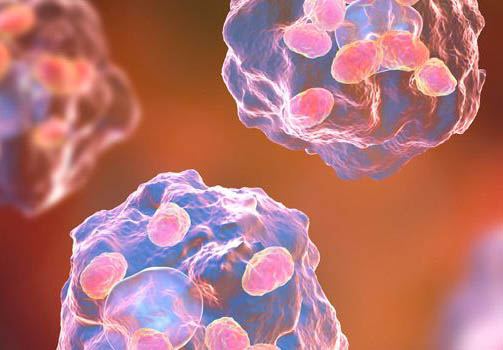Cellular Therapy Could Soothe Sarcoidosis
Cells From Bone Marrow Calm Damaging Immune Response

A new IRP study suggests that cells found in bone marrow could be used to calm out-of-control immune cells that harm the lungs of patients with sarcoidosis.
In patients with the inflammatory disease sarcoidosis, the body’s own immune cells rampage around the body like The Incredible Hulk set loose in a city, attacking both harmful pathogens and our own tissues. However, just like the Black Widow can calm The Hulk down and return him to human form in the Avengers films, cells isolated from our bone marrow may be able to change certain immune cells from a damaging state to a benign one, according to new IRP research.1
Cells called macrophages play a key role in guarding the body from infection. When they sense a threat, they release a substance called TNF-alpha that mobilizes the immune system and triggers inflammation in the body. In patients with sarcoidosis, macrophages release large amounts of TNF-alpha even when it is not needed, harming organs throughout the body and causing fevers, persistent fatigue, and chronic pain. The lungs are particularly vulnerable to the disease, with many patients developing shortness of breath and some progressing to potentially fatal lung disease.
Fortunately for patients with sarcoidosis and other disorders caused by an overzealous immune response, cells called mesenchymal stromal cells (MSCs), which are found in the spongy bone marrow that fills our bones, can reduce macrophages’ production of TNF-alpha. As a result, many researchers have tested MSC-based therapies for those sorts of diseases. An MSC-based therapy for sarcoidosis would likely have far fewer side effects than the standard anti-inflammatory medications currently used to treat the condition, such as steroids. These medications broadly suppress the immune system, leaving patients more vulnerable to infections, and they can also cause high blood pressure, diabetes, and other problems if used long-term.
“The theory behind using MSCs as a treatment is that, based on what we know, their anti-inflammatory effect is almost always very targeted and tailored to local conditions,” says the new study’s corresponding author, Krisztian Nemeth, M.D.,Ph.D., a postdoctoral research fellow in the lab of IRP senior investigator Eva Mezey, M.D., Ph.D. “These cells are smarter than a drug. They can sense their environment and react accordingly.”
“They have a flexibility that drugs don’t,” adds Dr. Mezey, one of the study’s two senior authors, along with IRP associate research investigator Joseph Fontana, M.D.

IRP senior investigator Eva Mezey
In the new study, the IRP researchers collected cells from the lungs of 17 patients with sarcoidosis who were taking minimal or no anti-inflammatory medications, as well as eight healthy volunteers. Those cells were then grown in the lab on plastic plates with or without MSCs from healthy donors and a substance called lipopolysaccharide, a component of bacteria that causes immune cells to mount a defensive response.
When exposed to both lipopolysaccharide and MSCs, the cells from the lungs of sarcoidosis patients produced much less inflammatory TNF-alpha than when they were exposed only to lipopolysaccharide. The patients’ cells also released much more IL-10, an anti-inflammatory chemical that tamps down the body’s immune response, when placed on plates with MSCs and lipopolysaccharide.
Further experiments that isolated macrophages from the lungs of two additional sarcoidosis patients confirmed that the changes in TNF-alpha and IL-10 levels on the plates containing MSCs were due to altered secretion of those two chemicals by lung macrophages rather than by other types of cells. Taken together, the study’s results confirm that MSCs affect lung macrophages in the same way they influence macrophages from other parts of the body.
“Just because scientists proved that certain macrophages from the bone marrow or developed from the blood can be suppressed by MSCs doesn’t necessarily mean that macrophages from other organs would behave the same way,” explains Dr. Nemeth. “You can’t take this for granted.”
Future studies will be needed to work out the precise details of how an MSC-based treatment for sarcoidosis might be administered, including how to deliver the MSCs to patients’ lungs. In most past clinical trials using MSCs, the cells have been injected into a vein, but they could also be introduced directly into the lungs by snaking a tube down the throat. In addition, it may be possible to develop a way for patients to breathe in MSCs via a device akin to the inhalers used by asthma patients. Once developed, these treatment approaches could be assessed for safety and effectiveness in clinical trials.
“By delivering the cells directly to the airway, we can potentially concentrate the effect of these cells in the lungs without affecting any other parts of the body,” says Dr. Nemeth. “Once you are able to shut down these macrophages in the lungs, you shut down their TNF-alpha production and you can potentially break the cycle of inflammation.”
Subscribe to our weekly newsletter to stay up-to-date on the latest breakthroughs in the NIH Intramural Research Program.
References:
[1] Bone Marrow-Derived Mesenchymal Stromal Cells (MSCs) Modulate the Inflammatory Character of Alveolar Macrophages from Sarcoidosis Patients. McClain Caldwell I, Hogden C, Nemeth K, Boyajian M, Krepuska M, Szombath G, MacDonald S, Abshari M, Moss J, Vitale-Cross L, Fontana JR, Mezey E. J Clin Med. 2020 Jan 19;9(1). pii: E278. doi: 10.3390/jcm9010278.
Related Blog Posts
This page was last updated on Tuesday, May 23, 2023
